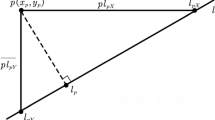Abstract
We consider a generalization of the Rectilinear Steiner Tree problem, where our input is classes of required points instead of simple required points. Our task is to find a minimum rectilinear tree connecting at least one point from each class. We prove that the version, where all required points lie on two parallel lines, called Rectilinear Class Steiner Tree (channel) problem, is NP-hard. But we give a linear time algorithm for the case where the points of each required class are clustered, and the classes consist of non overlapping intervals of points.
Similar content being viewed by others
References
P.K. Agarwal and M.-T. Shing, “Algorithms for special cases of rectilinear Steiner trees: 1. Points on the boundary of a rectilinear rectangle,”Networks 20 (1990) 453–485.
A.V. Aho, M.R. Garey and F.K. Hwang, “Rectilinear Steiner trees: Efficient special-case algorithms,”Networks 7 (1977) 37–58.
M.R. Garey and D.S. Johnson, “The rectilinear Steiner tree problem is NP-complete,”SIAM Journal on Applied Mathematics 32(4) (1977) 826–834.
M.R. Garey and D.S. Johnson,Computers and Intractability: A Guide to the Theory of NP-Completeness (Freeman, New York, 1979).
M. Hanan, “On Steiner's problem with rectilinear distance,”SIAM Journal on Applied Mathematics 14(2) (1966) 255–265.
E. Ihler, “Bounds on the quality of approximate solutions to the Group Steiner Problem,” in:Graph-Theoretic Concepts in Computer Science, WG90. Lecture Notes in Computer Science No. 484 (Springer, Berlin, 1991) pp. 109–118.
E. Ihler, “The complexity of approximating the Class Steiner Tree problem,” in:Graph-Theoretic Concepts in Computer Science, WG91. Lecture Notes in Computer Science No. 570 (Springer, Berlin, 1992) pp. 85–96.
B. Korte, H.J. Prömel and A. Steger, “Steiner trees in VLSI-layout,” in: B. Korte, L. Lovász, H.J. Prömel and A. Schrijver, eds.,Paths, Flows, and VLSI-Layout (Springer, Berlin, 1990) pp. 185–214.
T. Lengauer,Combinatorial Algorithms for Integrated Circuit Layout. (Wiley, New York, 1990).
T. Ottmann and P. Widmayer,Algorithmen and Datenstrukturen (BI-Wiss.-Verl., 1990).
G. Reich, “Shortest trees for intervals of points in the switchbox,” Technical Report, Institut für Informatik, Universität Freiburg (Freiburg, 1991).
G. Reich and P. Widmayer, “Approximate minimum spanning trees for vertex classes, Technical Report, Institut für Informatik, Universität Freiburg (Freiburg, 1989).
M. Sarrafzadeh and C.K. Wong, “New directions in the rectilinear Steiner tree problem, Technical Report, Department of Electrical Engineering and Computer Science, Northwestern University (Evanston), and IBM Watson Research Center, Yorktown Heights (New York, 1991).
Author information
Authors and Affiliations
Corresponding author
Additional information
Part of this research was conducted while the author was attending a research initiative at the Leonardo Fibonacci Institute, Povo, Italy.
Rights and permissions
About this article
Cite this article
Ihler, E. The rectilinear class Steiner tree problem for intervals on two parallel lines. Mathematical Programming 63, 281–296 (1994). https://doi.org/10.1007/BF01582073
Received:
Revised:
Issue Date:
DOI: https://doi.org/10.1007/BF01582073




